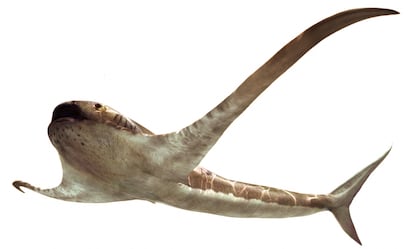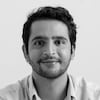The eagle shark that glided through the oceans 93 million years ago
A team of researchers has reconstructed the life of a species that was unknown to science following the discovery of a fossil in the small Mexican municipality of Vallecillo in 2012

Ninety-three million years ago a creature that would be quite unimaginable today roamed the oceans of North America. “When taking a first look at this specimen, you realize that you are witnessing something extraordinary and completely new,” says Romain Vullo of Geosciences Rennes, a research team set up by the University of Rennes and the French National Center for Scientific Research (CNRS) and which is leading studies on the first and only example of Aquilolamna milarcae. The common name for the species is eagle shark, given on account of its two huge pectoral fins, which are similar to those of a manta ray. The fossil was discovered in 2012 in Vallecillo, a small municipality in Mexico’s Nuevo León state, but it wasn’t until March 19 that it was documented in Science magazine.
When taking a first look at this specimen, you realize that you are witnessing something extraordinary and completely newRomain Vullo, researcher from Geosciences Rennes
“Its dimensions are unique and provide us with a lot of information about the ancient morphological diversity of sharks,” says Vullo. Aquilolamna milarcae was wider than it was long, measuring 1.9 meters from the tip of each wing-like fin and 1.6 meters from nose to tail. Its fossil has been dated to sometime in the mid-Cretaceous, the geological period spanning 145 million to 66 million years ago. “It’s a little older than a Tyrannosaurus rex,” Vullo adds.
Reconstructions based on the fossilized remains have brought to light some of the characteristics these animals displayed in life. Aquilolamna milarcae had ray-like wings but did not use them in the same way: mantas move theirs in an oscillatory, vertical motion. The eagle shark’s fins were practically immobile and used in much the same way as a modern paraglider, to help the creature to maintain its balance. It traveled through the water like a small subaquatic airplane, guided along gently by its tail fin.
Vullo, who specializes in vertebrate paleontology and Cretaceous life and has been fascinated by sharks since childhood, laughs as he explains that the most threatening thing about the eagle shark is probably its name. Its ponderous movement, flat head and small teeth indicate it was no prehistoric predator. The research team believes it was in all likelihood planktivorous.

The discovery is all the more exceptional, explains Vullo, because in shark paleontology, the most common thing is to find teeth and not skeletons, the cartilaginous composition of which make them less equipped for surviving the passage of millions of years. However, in the case of Aquilolamna milarcae, the opposite is true. Its bone structure is well-preserved but there are no teeth remaining in its mouth. This has posed the most difficult aspect of the investigation because teeth are the key to determining with the greatest level of certainty how an animal fed and how to classify it in comparison with other sharks. Other mysteries that remain to be solved are whether Aquilolamna milarcae had dorsal or pelvic fins, which were not identified when the fossil was uncovered.
To get an idea of the eagle shark’s habitat it is necessary to consider what the world was like during the mid-Cretaceous. Ninety million years ago, the water level of the world’s seas was considerably higher than today due to greater humidity and a lack of ice in the polar regions, Vullo explains. The oceans were between 150 and 200 meters higher than they are now and North America was divided into two islands, separated by a huge channel running from the Arctic Ocean through the middle of modern Canada down to the conjunction of the North Atlantic and Pacific in the Gulf of Mexico. The western chunk of the continent was delimited by the Rocky Mountains and the eastern portion by the Appalachians.
Its ponderous movement, flat head and small teeth indicate the eagle shark was no prehistoric predator
Vallecillo, which today is situated on an expanse of semi-arid land in northeastern Mexico, was once a coastal plain that eventually became a deposit for a preserved oceanic ecosystem. Although it was a good distance from the shoreline Mexico had during the Cretaceous period and the eagle shark probably spent most of its time in the ocean depths, it may have occasionally swum closer to the reefs abutting the coast.
“There was a very rich ecosystem in the Proto-Gulf of Mexico,” says Vullo. When animals died, their corpses sank to the ocean floor, where conditions were favorable for the preservation of their skeletons in the absence of scavengers and strong currents. “It was a pretty quiet ocean floor with very little activity and the sediment was very fine,” adds the paleontologist.
Therein lies the secret that has seen Vallecillo gain international fame as an exceptional site. It was in the same area that a Mauriciosaurus Fernandezi fossil was discovered in 2011, a marine reptile that was named in honor of Mauricio Fernández, a millionaire businessman and local politician who is seeking a fourth term as the mayor of San Pedro Garza García, the wealthiest municipality in Nuevo León and in Mexico.
“I never hoped to find such a crazy and incredible species,” Vullo admits, adding that he believes there will be many more finds in Vallecillo. “We have to wait and keep our fingers crossed.” In the meantime, the research team is trying to determine if teeth they have found in the vicinity belong to Aquilolamna milarcae and, if they are lucky, they hope to uncover another specimen that will help them to further understand the characteristics of the enigmatic eagle shark.
English version by Rob Train.
Tu suscripción se está usando en otro dispositivo
¿Quieres añadir otro usuario a tu suscripción?
Si continúas leyendo en este dispositivo, no se podrá leer en el otro.
FlechaTu suscripción se está usando en otro dispositivo y solo puedes acceder a EL PAÍS desde un dispositivo a la vez.
Si quieres compartir tu cuenta, cambia tu suscripción a la modalidad Premium, así podrás añadir otro usuario. Cada uno accederá con su propia cuenta de email, lo que os permitirá personalizar vuestra experiencia en EL PAÍS.
¿Tienes una suscripción de empresa? Accede aquí para contratar más cuentas.
En el caso de no saber quién está usando tu cuenta, te recomendamos cambiar tu contraseña aquí.
Si decides continuar compartiendo tu cuenta, este mensaje se mostrará en tu dispositivo y en el de la otra persona que está usando tu cuenta de forma indefinida, afectando a tu experiencia de lectura. Puedes consultar aquí los términos y condiciones de la suscripción digital.
More information
Archived In
Últimas noticias
Most viewed
- Sinaloa Cartel war is taking its toll on Los Chapitos
- Oona Chaplin: ‘I told James Cameron that I was living in a treehouse and starting a permaculture project with a friend’
- Reinhard Genzel, Nobel laureate in physics: ‘One-minute videos will never give you the truth’
- Why the price of coffee has skyrocketed: from Brazilian plantations to specialty coffee houses
- Silver prices are going crazy: This is what’s fueling the rally











































